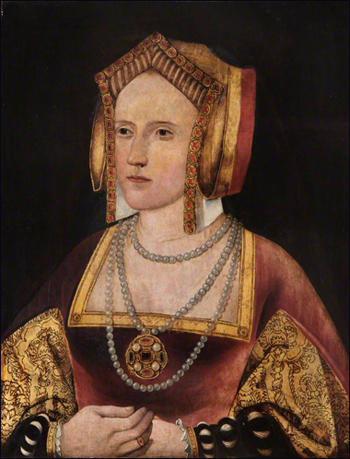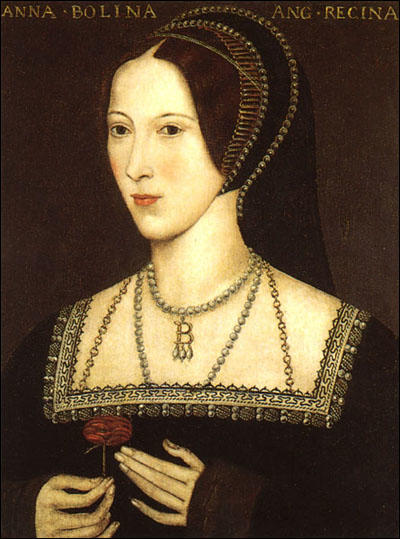Henry VIII: Catherine of Aragon or Anne Boleyn?
At the age of thirty-six Henry VIII fell deeply in love with Anne Boleyn, a woman some sixteen years his junior. Henry wrote Anne a series of passionate love letters. In 1526 he told her: "Seeing I cannot be present in person with you, I send you the nearest thing to that possible, that is, my picture set in bracelets ... wishing myself in their place, when it shall please you." Soon afterwards he wrote during a hunting exhibition: "I send you this letter begging you to give me an account of the state you are in... I send you by this bearer a buck killed late last night by my hand, hoping, when you eat it, you will think of the hunter."
Catherine of Aragon became concerned when Henry's illegitimate son, Henry FitzRoy, was brought to court in 1527. According to Peter Ackroyd: "Henry no longer frequented her bed." He had clearly given up hope that she would produce a son and heir. Henry also began consulting the Bible about his marriage. He had read the text in Leviticus that prohibited any man from marrying the widow of a dead brother. Henry now became convinced that God had denied him a royal heir as a punishment for marrying Arthur's widow.
Primary Sources

(Source 2) Anna Whitelock, Mary Tudor: England's First Queen (2009)
Henry maintained that it was a question posed by the Bishop of Tarbes, one of the French envoys, in the spring of 1527, that made him doubt the validity of the marriage of Catherine of Aragon, and therefore Mary's legitimacy. During the course of negotiations for the betrothal of Mary and the Duke of Orléans, the bishop had enquired whether in fact Mary was so great a prospect after all. Had not Henry married his brother's widow? Was that marriage valid? Was Mary legitimate? The envoys questions struck a resounding chord with the King.... The lack of a male heir, the successive failed pregnancies that had left the forty-two-year-old Queen seeming dowdy and dumpy, and the allure of the twenty-something Anne Boleyn, all contributed to Henry's mounting disillusionment with his Spanish wife.
(Source 3) Peter Ackroyd, Tudors (2012)
Catherine of Aragon... was aware of Henry FitzRoy, and was deeply offended when he was brought to court at precisely the time when it was clear that she could no longer bear children. Henry had in any case turned away from her. She was approaching the age of forty; all her early grace had faded, and the young king of France described her as "ugly and deformed". As a consequence, perhaps, Henry no longer frequented her bed. Most importantly she had failed in her primary duty to bear a son and heir.
(Source 4) Eric William Ives, Anne Boleyn : Oxford Dictionary of National Biography (2004-2014)
At first, Henry had no thought of marriage. He saw Anne Boleyn as someone to replace her sister, Mary (wife of one of the privy chamber staff, William Carey), who had just ceased to be the royal mistress. Certainly the physical side of his marriage to Catherine of Aragon was already over and, with no male heir, Henry decided by the spring of 1527 that he had never validly been married and that his first marriage must be annulled.... However, Anne continued to refuse his advances, and the king realized that by marrying her he could kill two birds with one stone, possess Anne and gain a new wife.
(Source 5) Alison Weir, The Six Wives of Henry VIII (2007)
Catherine was always an extremely popular queen... The main reason for it lay in her personal qualities, her unfailing graciousness and dignity and her kindness... The English had taken her to her hearts; they rejoiced on her marriage, grieved with her in her sorrows, and... were ready to champion her cause in the face of the King's displeasure.
(Source 6) Cardinal Jean du Bellay, report (May 1529)
If the matter (the divorce) were to be decided by women, he (Henry VIII) would lose the battle, for they did not fail to encourage the queen (Catherine of Aragon) at her entrance and departure by their cries, telling her to care for nothing, and other such words.
(Source 7) Lodovico Falier, letter to King Charles V (24th November, 1531)
It is said that more than seven weeks ago a mob of from seven to eight thousand women of London went out of the town to seize Boleyn's daughter, the sweetheart of the king of England, who was supping at a villa on a river, the king not being with her; and having received notice of this, she escaped by crossing the river in a boat. The women had intended to kill her; and amongst the mob were many men, disguised as women. Nor has any great demonstration been made about this, because it was a thing done by women.
(Source 8) Antonia Fraser, The Six Wives of Henry VIII (1992)
Let us return to that winter of 1501 and the brief months of "married life" which Arthur and Catherine enjoyed following their ceremonial wedding and bedding at Baynard's Castle. Arthur's physical immaturity and lack of growth - even shorter than his admittedly tiny wife - has already been stressed. This is in itself no proof that he had not reached puberty (although it makes it seem unlikely) and, even if he had not reached it in November, he might have reached it at some point during the next few months. Catherine's story years later in the confessional to Cardinal Campeggio was that they had shared a bed on only seven occasions, and at no time had Arthur "known" her. But what really stands against the notion of the consummation of the union, all subsequent allegations apart, is that the custom of the time was all against it.
In an age when marriages were frequently contracted for reasons of state between children or those hovering between childhood and adolescence, more care rather than less was taken over the timing of consummation. Once the marriage was officially completed, some years might pass before the appropriate moment was judged to have arrived. Anxious reports might pass between ambassadors on physical development; royal parents might take advice on their offsprings' readiness for the ordeal. The comments sometimes remind one of those breeders discussing the mating of thoroughbred stock, and the comparison is indeed not so far off. The siring of progeny was the essential next step in these royal marriages, so endlessly negotiated.
Where an heiress was concerned, her "spoiling" by being obliged to have sex and bear children too young might have important consequences. The physique of the great heiress Margaret Beaufort was considered to have been ruined by early childbearing. She bore the future Henry VII when she was only thirteen, and never had any other children in the course of four marriages.
(Source 9) Cardinal Lorenzo Campeggi report to Pope Clement VII (October 1528)
Catherine of Aragon... intends to live and die in the estate of matrimony, into which God had called her, and that she would always be of that opinion and never change it.... She insists that everything shall be decided by judicial sentence... Neither the whole kingdom on the one hand, nor any great punishment on the other, although she might be torn limb by limb, should compel her to alter this opinion.

(Source 11) Alison Plowden, Tudor Women (2002)
When the Pope's representative, Cardinal Campeggio, came over to England in 1528 to try to arrange an amicable settlement, he found Catherine immovable in her determination to defend to the last the soul and the honour of her husband and herself. She utterly rejected the suggestion that she should give in gracefully and retire into a nunnery. She had no vocation for the religious life and intended to live and die in the estate of matrimony to which God had called her. But, she told Campeggio, she was an obedient daughter of the Church. She would submit to the Pope's judgement in the matter and abide by his decision, whichever way it might go. Unless and until judgement was given against her, she would continue to regard herself as the King's lawful wife and England's Queen.
Questions for Students
Question 1: According to source 2, what happened in the spring of 1527 that encouraged Henry VIII to think about marrying Anne Boleyn?
Question 2: Read about Henry FitzRoy. Why did Catherine of Aragon become concerned when Henry VIII brought him to court in 1527?
Question 3: Select information from the sources that helps to explain why Henry VIII wanted to marry Anne Boleyn.
Question 4: In source 5, Alison Weir says that "Catherine was always an extremely popular queen". Select two examples from sources that were written at the time that supports this statement.
Question 5: What did Cardinal Lorenzo Campeggi advise Catherine of Aragon to do?
Question 6: What information did Henry VIII find in the Bible to justify divorcing Catherine of Aragon. How did Catherine counteract this argument?
Answer Commentary
A commentary on these questions can be found here
Download Activity
You can download this activity in a word document here
You can download the answers in a word document here
